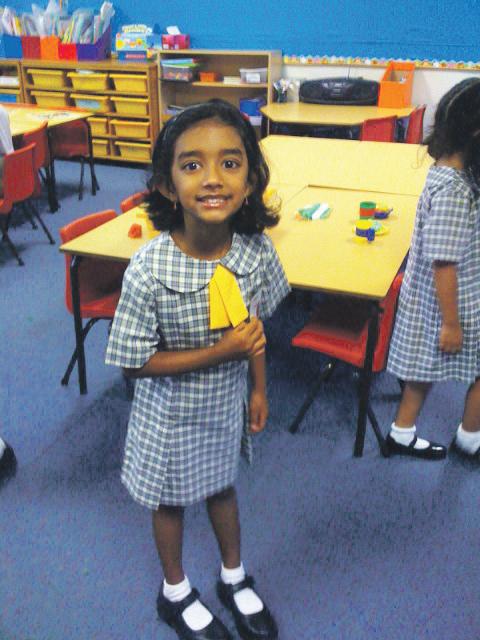
13 minute read
All set for big school
from 2013-03 Sydney (1)
by Indian Link
Toilet partners
My school is great! On my first day, my friend Meisha was my toilet partner. When we had to go to the toilet, we would go together. After school, I went to the school park with my mum and sister because I wasn’t tired. The next day also I went to the park after school and showed my friend who my mum was. I like school, its lots of fun!
Marcus Miranda Epping Heights Public School Carlingford, NSW

Too nosey I like my Kindy, it’s fun and I’ve made some friends. But when I first came to the class, I didn’t know anyone’s names. I called one girl ‘Nosey’ because her nose was always running. When I told my mum, she found that girl because of her nose. Now that I know the names of my friends, I don’t have to call them anything else. But the Nosey girl is not my friend, because her nose still runs.
Maya JhaveriParadise Kindergarten/East Marsden Public School Adelaide
Made a friend
I’m 5 and a big girl because I’m going to school now. On my first day of school
I learned many things like how to drink from the bubbler. I also made a new friend, but I didn’t know her name then. I know it now, and she is still my friend. On my first day, I told my mum what I wanted for lunch and she packed it. I wore my uniform, had my bag packed and we went to school. It was exciting and I liked it.

Sai Hasini Madukuri Darcy Road Public School, Wentworthville, NSW
myPlayingwith friends
I like my school, I’ve made lots and lots of new friends. I play with them, so now I don’t have to only play with my big sister. I get tired and wish mum would park the car closer so I wouldn’t have to walk so far when school’s over, but it’s still a lot of fun!
Reece Gaete John Palmer Public School KellyvilleRidge
Biggirlnow

I love school! I have been to school for only a few days, but I had lots of practice at my preschool. On my first day, I woke up early and put on my uniform, I told my mum what I wanted in my lunchbox and got my bag ready. I’m a big girl now, and am excited to go to school.

Akansha Harekoppa Darcy Road Public SchoolWentworthville, NSW



Fun, not ABC I liked my first day at school. My mum and dad told me that I would learn ABC and 1-2-3 at school, but I just played and had fun. I told my mum that I didn’t learn ABC and she just laughed. My dad asked what I had learned and I said nothing. But then he said that if I didn’t learn anything, I don’t need to go to school. So I told him what I did because I want to go to school. He can be so bossy!
Siona TrivediRedeemer Baptist School North Parramatta, NSW




free Call auStralia wide 1800 070 921 Sydney * MelBourne * BriSBane * adelaide * Perth
A child, dressed as Lord Shiva, plays with sand on the banks of the Sangam in Allahabad during the Maha Kumbh. The Kumbh Mela, which runs from January till March takes place every 12 years in Allahabad.

Serious lapses in $9.5 billion farm loan waiver scheme: CAG
The government has again come under attack for a corruption scandal -- this time related to the 2008 Rs.52,000 crore ($9.5 billion) farm loan waiver scheme, in which the official auditor has pointed out serious lapses and malpractices.
In a report tabled in parliament on the “Implementation of Agricultural Debt Waiver and Debt Relief Scheme, 2008”, the Comptroller and Auditor General (CAG) said there were irregularities in at least one in five cases.
Thousands of ineligible persons were given the benefits while deserving ones were denied, CAG said in the report.
“Overall, the performance audit revealed that in 20,216 or 22.32 percent of the 90,576 cases test checked in audit, there were lapses/errors which raised serious concerns about the implementation of the scheme,” the CAG said.
Prime Minister Manmohan Singh’s government had announced a debt waiver for farmers across the country in 2008, a move that analysts say helped the government win the 2009 general election.
“Farmers who had taken loan for nonagricultural purposes or whose loans did not meet eligibility conditions, were given benefits under the scheme,” the CAG said.
The scheme was originally estimated to benefit 3.69 crore marginal and small farmers and 60 lakh other farmers.
Over the last four financial years, the government has waived more than Rs.52,000 crore in loans related to approximately 3.45 crore small, marginal and other farmers.
“It was found that out of the 9,334 accounts test checked in audit across nine states, 1,257 accounts, or 13.46 percent were such who were found to be eligible for benefit of Rs.3.58 crore under the scheme, but were not considered by the lending institutions while preparing the list of eligible beneficiaries,” the government’s auditor said.
Terming the incident a big “scam”, the main opposition Bharatiya Janata Party (BJP) demanded a Central Bureau of
Investigation (CBI) inquiry to unearth the real extent irregularities.
“CAG has found out that 13 percent eligible farmers were not considered by lending institutions. Also 8.5 percent ineligible beneficiaries got benefits,” said BJP spokesperson Prakash Javadekar.
Hyderabad blasts: Court warrants against Riyaz Bhatkal
A Delhi court issued non-bailable warrants against banned terror outfit Indian Mujahideen founder Riyaz Bhatkal and nine other alleged operatives in the Feb 21 Hyderabad twin blasts.
A National Investigation Agency (NIA) special court, during an in-chamber hearing, issued the warrants against Riyaz Bhatkal, suspected to be based in Pakistan, and nine other terror group operatives: Iqbal Bhatkal, Mohsim Chaudhary, Amir Reza Khan, Shahnawaz Alam, Asadullah Akhtar, Ariz Khan, Mohd. Khalid, Mirza Shadaab Beg and Mohd. Sajid.
District Judge I.S. Mehta also sent two alleged IM operatives Syed Maqbool and Imran Khan back to judicial custody till March 13, after expiry of their five-day NIA custody.
The NIA questioned the two over the Hyderabad twin blasts.
The agency told the court that Maqbool and Khan were taken to Hyderabad and they revealed some important facts about the blasts, court sources said.
Maqbool and Khan had in July 2012 surveyed Hyderabad’s Dilsukhnagar, where the Feb 21 blasts took place, the NIA said.
The NIA told the court that the conspiracy behind the Hyderabad blasts was hatched by IM modules and they also moved an application for issuing production warrant against alleged IM operative Obaid-ur-Rehman, currently lodged in a Bangalore jail.
Allowing the application of NIA, the court issued production warrant against Rehman. The Hyderabad twin blasts, that killed 16 people and injured 117, were carried out on the instructions of Riyaz Bhatkal, according to the NIA.
A democratic, secular Bangladesh in India’s interest: President
President Pranab Mukherjee said a “democratic, secular and progressive” Bangladesh was in India’s interest and India had conveyed the need to maintain communal peace and harmony at a time the neighbouring country is rocked by clashes that has seen over 70 deaths.
“A democratic, secular and progressive Bangladesh is clearly in India’s interest,” the president said in a statement on his way back from his three-day maiden visit to Bangladesh.
“In this context, we conveyed to all our interlocutors the need for an inclusive political process; and the maintenance of communal peace and harmony.”
He said India was hopeful that internal political differences in Bangladesh can be resolved through dialogue “and that the rights of all communities would be fully respected”.
Mukherjee was referring to the clashes in Bangladesh between the Jamaat-e-Islami and the authorities recently that has left over 70 people dead. The Jamaat, a key ally of the opposition Bangladesh National Party, called a hartal or strike March 3 and 4, during the Indian president’s state visit.
Earlier, Bangladesh Foreign Minister Dipu Moni had compared the violence unleashed by the Jamaat to that by proPakistani elements in 1971. She had said the Islamists were attacking temples and burning the homes of minorities in Bangladesh.
Mukherjee said he was returning from Bangladesh “with the hope and confidence that India and Bangladesh can together build a better future for our people, and that our relations can serve as an example for the rest of South Asia”.
“My visit has served to reinforce the special importance that the government and people of India attach to developing the best possible relations with an important and large neighbour like Bangladesh.
“We believe that a strong, stable and rapidly developing Bangladesh is in the interest of not only its people but in the interest of the entire region. I, therefore, assured the government and people of Bangladesh that India will be a willing, longterm development partner,” he said.
Mukherjee said he was “impressed by the vibrancy” of its people.
“Like India, they have a large population of youth. They are committed to democracy, tolerance, an inclusive social order, free media and building a modern and progressive state,” he said.
“They seek to consolidate the institutes of democracy and keep alive the spirit of their liberation struggle. We wish them well in this great endeavour,” he added.
He also stressed on the need to enhance greater people to people exchanges.
“I made it clear that we wish to grow together with Bangladesh because our destinies are interlinked. Apart from bilateral cooperation, we are now preparing to expand our cooperation at the subregional level. This holds great promise for the security, growth and connectivity that can transform the entire region,” he added.
US honours Indian as exchange alumni
India’s Shubhalaxmi Vaylure has been selected by US State Department as International Exchange Alumni Member for March for her dedication to building greater environmental awareness in India.
Dr Shubhalaxmi’s will be recognized on the International Exchange Alumni website, the Bureau of Educational and Cultural Affairs’ official website for the more than one million Department-sponsored exchange alumni worldwide.
Shubhalaxmi first came to the US in 2003 as part of the Fulbright IndoAmerican Environmental Leadership Programme which took her to the University of Montana to study educational nature centres, the State Department announcement said.
Upon returning from this programme, she drew inspiration from her Fulbright Programme as she implemented innovative educational Programmes at the Mumbai Conservation Education Centre.
Shubhalaxmi went on to study non-profit management at Boston University through the Hubert H. Humphrey Programme. This experience enabled her to bring her environmental advocacy to a new level.
Returning from the Humphrey Programme, she developed online courses in natural history and worked in the organization development sector of the Bombay Natural History Society where she conducted staff training workshops and boosted fundraising and marketing efforts to benefit the Centre.
In 2012, Dr. Shubhalaxmi and a team of her alumni peers won support from the State Department’s Bureau of Educational and Cultural Affairs Alumni Engagement Innovation Fund to provide management trainings for professionals from Indian environmental NGOs. The team has already trained nearly 150 individuals.
Shubhalaxmi Vaylure loves nature, according to her official biography. On her Facebook page, her “dream house” overlooks a lush, marshy, nature scene. “It was in my childhood that I got the nature bug,” she said. “I spent my growing years surrounded by trees and bees. Science was my favourite subject.”
Indian-origin science writer wins British Physics journalism prize
Anil Ananthaswamy, a London based Indian origin writer, has won the inaugural Physics Journalism Prize sponsored by the Institute of Physics (IOP) and the Science and Technology Facilities Council (STFC).
The prize is designed to inspire the next generation of physicists by encouraging journalists to grapple with often complex topics and help spread excitement about the subject, according to an IOP release forwarded by the American Astronomical Society.
Ananthaswamy, a consultant at New Scientist Magazine and author of The Edge of Physics, has won the prize for his article Hip Hip Array, which focuses on the Square Kilometre Array, an international project to design and build the largest radio telescope ever conceived.
“Anil Ananthaswamy is being awarded the prize for writing a feature which brings one of the world’s most exciting astronomical endeavors to life -- the Square Kilometre Array,” said IOP President Sir Peter Knight.
The Physics Journalism Award offers the prize of an expenses paid trip to Japan, to visit world-leading facilities carrying out research at the frontiers of physics.
On winning, Ananthaswamy commented, “Writing about physics, especially about the work being done in remote, difficult and sometimes hostile environments, is a special pleasure. Winning an award for doing what I love to do is just icing on the cake. I truly appreciate the recognition.”
Mark Henderson, Head of Communications at the Wellcome Trust and former Science Editor at The Times, said, “Anil Ananthaswamy has an eye for illustrative detail of which the best travel writers would be proud.”
Kirsten Bodley, Chief Executive of STEMNET, said, “The winning article on the competition for the Square Kilometre Array will be particularly inspirational to young people, offering them an opportunity to see how fascinating contemporary physics research can be.”
Commenting on the winner’s choice of topic, Terry O’Connor, Head of Communications at STFC, added, “The Square Kilometre Array will open new avenues of research, and delve further back into the formation of the universe.”
A million-dollar prize for Delhi slum education project
A “hole in the wall” experiment in a Delhi slum, demonstrating how children collectively can teach themselves complex issues, has won educator Sugata Mitra the first one million dollar 2013 TED Prize.
Mitra, an education technology professor at Newcastle University in the United Kingdom, said he will use the prize, awarded by TED, an annual global ideas conference, to launch a global initiative for self-directed learning that builds on his discovery.
“My wish is to help design the future of learning by supporting children all over the world to tap into their innate sense of wonder and work together,” he said in his acceptance speech Tuesday at the TED 2013 conference in Long Beach, California.
“Help me build the School in the Cloud, a learning lab in India, where children can embark on intellectual adventures by engaging and connecting with information and mentoring online,” Mitra said outlining his plan to build a child-driven virtual school.
“I also invite you, wherever you are, to create your own miniature child-driven learning environments and share your discoveries,” he said asking the global TED community to make his dream a reality with Self-Organized Learning Environments (SOLEs) in homes, schools, and community programmes worldwide.
The TED Prize is awarded annually to an exceptional individual who receives $1,000,000 and the TED community’s resources and expertise to spark global change.
According to TED, after a series of experiments revealed that groups of children can learn almost anything by themselves, Mitra began his pursuit to inspire children all over the world to get curious and work together.
In 1999, Mitra and his colleagues dug a hole in a wall bordering a slum in Kalkaji in south Delhi, installed an Internet-connected PC, and left it there (with a hidden camera).
Soon, they saw kids from the slum playing with the computer, learning English and searching through a wide variety of websites on science and other topics, and then teaching each other.
Mitra and his colleagues carried out experiments for over 13 years on the nature of self-organized learning, its extent, how it works and the role of adults in encouraging it.
Lara Stein, director of the TED Prize, said Mitra “has not only created a remarkable body of research around selfdirected learning, but he has support from teachers around the world who are tapping into his methodology with great success.”
AIFF happy with positive reaction from corporates
The All India Football Federation (AIFF) was happy with the positive reaction they got from 30 interested corporate groups, who have shown interest in bidding for two new teams for the 2013-14 I-League.
Prominent groups like Hero Motors, Sahara, GMR, Venky’s, Piramal, Dodsal
Group, IL&FS, JSW, and DSK attended the Open House session at the Football House.
AIFF president Praful Patel said it was important for all the clubs to have their own infrastructure.
“Take it from me; this initiative will help all existing clubs find partners. Clubs will fulfill the club licensing criteria which is very essential for development infrastructure and youth development. Every English Premier League club has a ground, which they call their home ground. Here no club has that.
“In Kolkata four teams use the same ground. Now with two new clubs backed by corporate bodies coming up, these issues are expected be sorted out as they will be under the club licensing criteria. All the other existing clubs will follow suit and in the process we can dream of a better League and perhaps one day compare with the best Leagues in the world,” he said.
Patel said that the AIFF will host a similar Open House in Dubai by the end of this month to attract foreign investors from Gulf and Europe. The AIFF has no objections if any of the Indian clubs want to partner an overseas club as a co-branded unit.
I-League chief executive Sunando Dhar told IANS that the AIFF was happy with the response they received from the corporates.
“Today some 30 corporates turned up for the meeting. We are happy with the response that we got from the corporates,” he said.
AIFF vice-president Subrata Dutta told IANS that the corporates were asked to fulfill two criteria - invest in infrastructure for the next five years and that they should bid for any city except from states of Goa and West Bengal.
“We told the corporates that we want clubs from north, northeast, south and western India. We also want them to invest in infrastructure for the next five years,” he said.
Sahara are interested in fielding a team from Lucknow and GMR from Hyderabad. Both Sahara and GMR own Indian Premier League (IPL) franchises in Pune and Delhi, respectively.
Abhijit Sarkar, head of corporate communications of Sahara, was all praise about the initiative.
“This is an excellent initiative from AIFF. Football needed this to grow and I am glad that it is finally happening. There is market in India for the sport which is so popular here,” he said.
The AIFF is also planning to keep the two new teams safe from relegation for the next two years.
The process of registering new teams is likely to be completed by the end of April. It will help the two new teams to recruit footballers when the transfer window opens up June 9.
Two teams - ONGC and Air India - are likely to be dropped from the I-League after they failed to fulfill the Asian Football Confederation (AFC) club licensing criteria despite repeated reminders.
Kolkata exhibits unknown women freedom fighters

Heroic acts of lesser-known women revolutionaries from 20th century undivided Bengal have come to life through rare photographs at the Women Revolutionaries of Bengal exhibition that began in Kolkata.
“We gathered the photographs based on Intelligence Bureau files. We found mention of 173 women convicted during the early part of the 20th century from undivided Bengal. Out of these, 118 have been displayed at the exhibition,” Simonti Sen, director, West Bengal State Archives, said.
The black and white photographs of the convicts from areas like Faridpur, Chittagong and Kolkata are accompanied with write-ups to elucidate their roles in the freedom struggle.
“All of them were convicted for various reasons during the period from early 1920s to late 1940s. Some were interned, some externed, while some were imprisoned. Most of them were from the eastern part of the then undivided Bengal,” Sen said.
According to Sen, the exhibition will be an enriching experience for students as well as history scholars.
“Text books mention women freedom fighters like Kalpana Datta and Pritilata Waddeddar. But these women are never encountered in text books. Scholars can use them to study further,” said Sen. IANS









